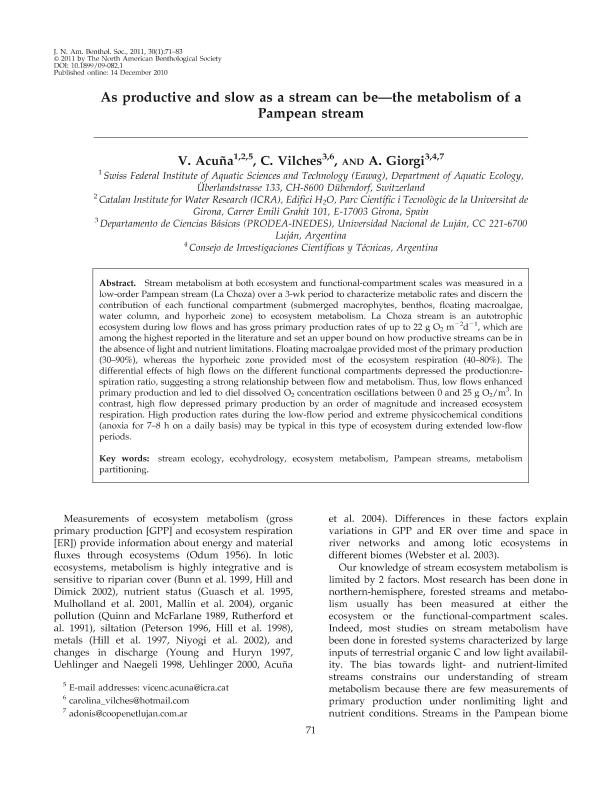Mostrar el registro sencillo del ítem
dc.contributor.author
Acuña, V.
dc.contributor.author
Vilches, Carolina

dc.contributor.author
Giorgi, Adonis David Nazareno

dc.date.available
2023-04-03T16:56:36Z
dc.date.issued
2011-03
dc.identifier.citation
Acuña, V.; Vilches, Carolina; Giorgi, Adonis David Nazareno; As productive and slow as a stream can be-the metabolism of a Pampean stream; North Amer Benthological Soc; Journal Of The North American Benthological Society; 30; 1; 3-2011; 71-83
dc.identifier.issn
0887-3593
dc.identifier.uri
http://hdl.handle.net/11336/192501
dc.description.abstract
Stream metabolism at both ecosystem and functional-compartment scales was measured in a low-order Pampean stream (La Choza) over a 3-wk period to characterize metabolic rates and discern the contribution of each functional compartment (submerged macrophytes, benthos, floating macroalgae, water column, and hyporheic zone) to ecosystem metabolism. La Choza stream is an autotrophic ecosystem during low flows and has gross primary production rates of up to 22 g O2 m-2d-1, which are among the highest reported in the literature and set an upper bound on how productive streams can be in the absence of light and nutrient limitations. Floating macroalgae provided most of the primary production (30-90%), whereas the hyporheic zone provided most of the ecosystem respiration (40-80%). The differential effects of high flows on the different functional compartments depressed the production:respiration ratio, suggesting a strong relationship between flow and metabolism. Thus, low flows enhanced primary production and led to diel dissolved O2 concentration oscillations between 0 and 25 g O2/m3. In contrast, high flow depressed primary production by an order of magnitude and increased ecosystem respiration. High production rates during the low-flow period and extreme physicochemical conditions (anoxia for 7-8 h on a daily basis) may be typical in this type of ecosystem during extended low-flow periods.
dc.format
application/pdf
dc.language.iso
eng
dc.publisher
North Amer Benthological Soc

dc.rights
info:eu-repo/semantics/openAccess
dc.rights.uri
https://creativecommons.org/licenses/by-nc-sa/2.5/ar/
dc.subject
ECOHYDROLOGY
dc.subject
ECOSYSTEM METABOLISM
dc.subject
METABOLISM PARTITIONING
dc.subject
PAMPEAN STREAMS
dc.subject
STREAM ECOLOGY
dc.subject.classification
Ecología

dc.subject.classification
Ciencias Biológicas

dc.subject.classification
CIENCIAS NATURALES Y EXACTAS

dc.title
As productive and slow as a stream can be-the metabolism of a Pampean stream
dc.type
info:eu-repo/semantics/article
dc.type
info:ar-repo/semantics/artículo
dc.type
info:eu-repo/semantics/publishedVersion
dc.date.updated
2023-03-30T14:47:35Z
dc.journal.volume
30
dc.journal.number
1
dc.journal.pagination
71-83
dc.journal.pais
Estados Unidos

dc.description.fil
Fil: Acuña, V.. Swiss Federal Institute of Aquatic Sciences and Technology; Suiza. Universidad de Girona; España
dc.description.fil
Fil: Vilches, Carolina. Consejo Nacional de Investigaciones Científicas y Técnicas. Oficina de Coordinación Administrativa Parque Centenario. Universidad Nacional de Luján. Instituto de Ecología y Desarrollo Sustentable; Argentina
dc.description.fil
Fil: Giorgi, Adonis David Nazareno. Consejo Nacional de Investigaciones Científicas y Técnicas. Oficina de Coordinación Administrativa Parque Centenario. Universidad Nacional de Luján. Instituto de Ecología y Desarrollo Sustentable; Argentina
dc.journal.title
Journal Of The North American Benthological Society

dc.relation.alternativeid
info:eu-repo/semantics/altIdentifier/url/https://www.journals.uchicago.edu/doi/full/10.1899/09-082.1
dc.relation.alternativeid
info:eu-repo/semantics/altIdentifier/doi/http://dx.doi.org/10.1899/09-082.1
Archivos asociados
